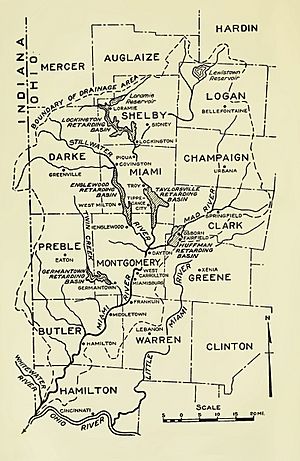Miami Valley facts for kids
The Miami Valley is a special area in southwest Ohio, USA. It's named after the Miami Indians who once lived there. This region is mostly the land around the Great Miami River. It also includes other important rivers like the Little Miami, Mad River, and Stillwater River.
Geographically, the Miami Valley includes cities like Dayton, Springfield, Middletown, and Hamilton. However, when people talk about the "Miami Valley," they often mean the area around Greater Dayton. This is because Dayton is a big center for business and culture in the region.
You might hear the name "Miami Valley" used by local groups and businesses. For example, there's the Miami Valley Career Technology Center, Miami Valley Hospital, and the Miami Valley Council of the Boy Scouts of America. While Middletown and Hamilton are geographically in the valley, they are often more connected to the larger city of Cincinnati for their economy and culture.
Contents
History of the Miami Valley
In the middle of the 1900s, the Miami Valley was home to some very large companies. These businesses provided many jobs for people living in the area. Some of the biggest employers included:
- Procter and Gamble in Cincinnati, known for household products.
- Champion Paper and Fiber in Hamilton, a big paper company.
- Armco in Middletown, a steel manufacturing company.
- National Cash Register in Dayton, which made cash registers and later computers.
These companies played a huge role in the economy of the Miami Valley for many years.
Counties and Cities in the Valley
Local television stations often include many counties and cities in their news and weather coverage of the Miami Valley. This shows how wide the cultural and economic influence of the region is. Here are some of the main counties and their biggest cities that are considered part of the Miami Valley:
- Montgomery County (home to Dayton)
- Greene County (including Xenia)
- Preble County (with Eaton)
- Clark County (where Springfield is located)
- Miami County (including Troy)
- Darke County (home to Greenville)
- Champaign County (with Urbana)
- Shelby County (including Sidney)
- Logan County (where Bellefontaine is)
- Butler and Warren counties (including Middletown)
- Wayne County, Indiana (with Richmond)
- Mercer County (including Celina)
- Auglaize County (where Wapakoneta is)
Some news channels also include these nearby areas in their coverage:
- Clinton County (with Wilmington)
- Union County, Indiana (including Liberty)
- Randolph County, Indiana (where Winchester is)
Major Roads and Highways
The Miami Valley has many important roads that help people travel and transport goods. These highways connect cities within the valley and to other parts of the country.
- Interstate 75 - This major highway runs north to south right through the valley and downtown Dayton.
- Interstate 70 - This highway crosses the valley from east to west, connecting many areas.
- Interstate 71 - Running north to south, this highway is on the eastern side of the Miami Valley.
- Interstate 675 - This road acts as a bypass around Dayton. It connects I-75 south of the city to I-70 east of it.
- U.S. Route 35 - This route goes from east to west through the Dayton area.
- U.S. Route 68 - This road runs north to south through the farmlands in the eastern part of the Miami Valley.
- U.S. Route 127 - This route travels north to south through several cities and smaller towns in the western Miami Valley.
- Ohio State Route 129 - This state route connects the city of Hamilton to Interstate 75.
- Ohio State Route 49 - This road forms a bypass west of Dayton and continues north into Darke County.
Population and Growth
The Greater Cincinnati region is growing northward. It is expanding through Butler County, which is part of the Miami Valley. Because of this growth, it's possible that the Cincinnati and Dayton metropolitan areas could become one large region by the year 2030.
If this happens, the U.S. Census Bureau might start reporting them as a single, very large metropolitan area. This new combined area would have a population of almost 3 million people. This would make it one of the top 20 most populated metropolitan areas in the United States, similar in size to places like the Orlando–Deltona–Daytona Beach, FL area.



